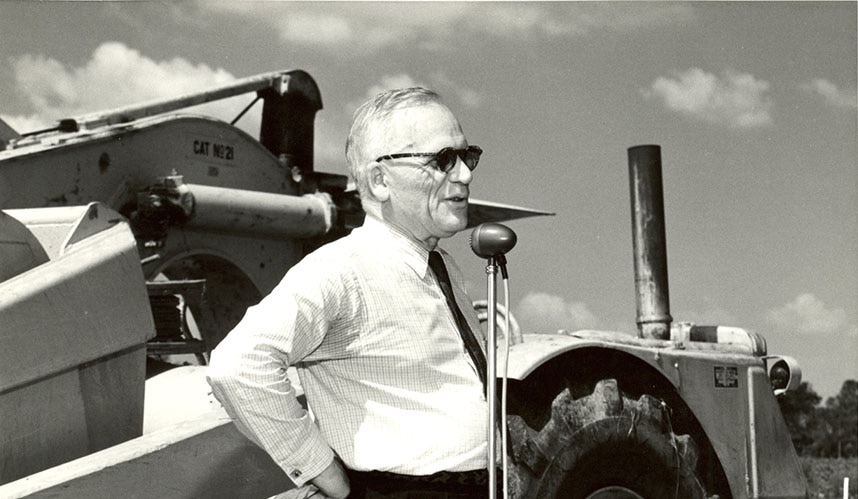A hard-driving man nicknamed “Dutch” Beutel ran Dow’s Gulf Coast operations at Freeport, Texas, during the 1940s. Texas Operations – and Beutel – became legendary.
 In 21 years under Dutch Beutel’s direction, Dow’s Freeport site went from 800 acres of bare land to more than 3,000 acres and numerous plants. Photo courtesy of Dow Texas Operations historical collection.
In 21 years under Dutch Beutel’s direction, Dow’s Freeport site went from 800 acres of bare land to more than 3,000 acres and numerous plants. Photo courtesy of Dow Texas Operations historical collection.Photo credit: Herbert H. and Grace A. Dow Foundation
Building an Empire
In the 1940s, Alfred P. (Dutch) Beutel, second in command at Dow and the first leader of Dow’s Texas Division, led the way for the identification and growth of Dow’s Texas Gulf Coast operations. Famous for getting things done, Beutel helped shape Dow’s Freeport site into the largest chemical manufacturing site in the world in just 21 years. His legacy also includes championing the selection of Freeport as a Dow location and building the community of Lake Jackson.
 Dow purchased land on Freeport Harbor in 1940 to assist in magnesium extraction. Photo courtesy of Dow Texas Operations historical collection.
Dow purchased land on Freeport Harbor in 1940 to assist in magnesium extraction. Photo courtesy of Dow Texas Operations historical collection.A Freak Ice Storm
In the 1930s, Dow began looking to expand its operations outside of Michigan to the U.S. Gulf Coast. Soon, two Texas sites stood out: Corpus Christi and Freeport. With most Dow board members favoring Corpus Christi, a board of directors’ meeting to choose the site was held in January 1940 at a Corpus Christi hotel. However, a “norther” blew into town, bringing a massive ice storm. The board packed up and moved up the coast to Freeport, where the sun was shining. On March 7, 1940, Dow bought 800 acres bordering the Freeport Harbor. Freeport had everything needed for a chemical plant: seawater rich in magnesium and bromine, salt domes and natural gas within easy reach, an ocean port – and good weather on the right day.
 Striking “silver” metal (magnesium) in the seas of Texas – artwork from vintage Dow ad, circa 1943.
Striking “silver” metal (magnesium) in the seas of Texas – artwork from vintage Dow ad, circa 1943.Deep in the Heart of Texas
It was January 21, 1941, during the midst of World War II, when Dow’s new magnesium plant in Texas officially started production. A vital element for the production of airplanes, the silvery-white metal was in high demand for the war effort. Dow had developed a way to mine magnesium from seawater, making the Gulf Coast an ideal location. Following the war, Dow’s magnesium, also known as DOWMETAL, went on to be used in a variety of applications, from tools to automotive engine pistons.
 Dow purchased land on Freeport Harbor in 1943 to assist in magnesium extraction. Oyster shells were one of several resources and attributes that made Freeport, Texas, attractive to Dow.
Dow purchased land on Freeport Harbor in 1943 to assist in magnesium extraction. Oyster shells were one of several resources and attributes that made Freeport, Texas, attractive to Dow.Serving Up an Old Favorite with a Twist of Lime
With Beutel in charge, the Freeport construction was fast and efficient. The chlorine-caustic plant started in late December 1940, and the magnesium-from-seawater plant came next. This was followed closely by the lime plant, which used oyster shells as a raw material. The shells were rich with lime, a critical ingredient for extracting magnesium from seawater. Using lime during the extraction process eliminated boron, enabling higher production output to meet the wartime demand for this valuable metal.
 Aerial view of Dow’s Gulf Stream expansion project in Freeport, Texas, 2015.
Aerial view of Dow’s Gulf Stream expansion project in Freeport, Texas, 2015.From Vision to Vibrancy: A Century of Gulf Coast Growth
Today Dow’s Freeport site is the largest integrated chemical manufacturing facility in the Western Hemisphere and home to Dow’s new state-of-the-art ethylene facility – the cornerstone of Dow’s $12 billion in growth investments on the U.S. Gulf Coast. The facility, which started up in September 2017, has a nameplate capacity of 1.5 million metric tons. Leveraging the U.S. shale gas advantage, Dow’s Gulf Coast investments are designed to strengthen Dow’s competitiveness in downstream, consumer-led industries such as packaging, infrastructure and consumer care.
Housing the droves of new employees and construction workers coming to Freeport was a challenge. how Brazoria County’s largest city – “Camp Chemical” – was created in two months.






